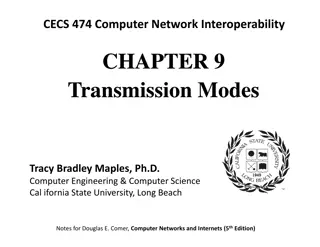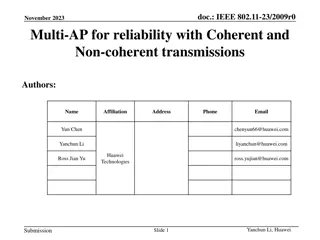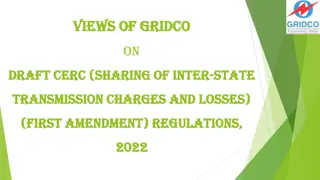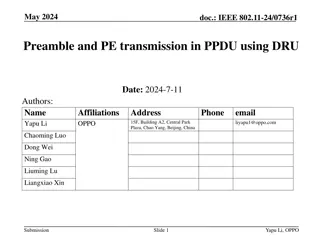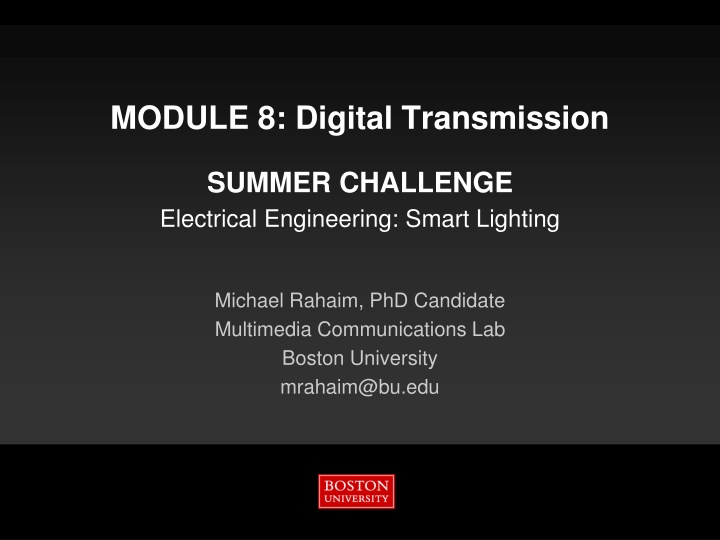
Digital Transmission and Smart Lighting in Electrical Engineering
Explore Module 8 on Digital Transmission featuring topics such as Binary Representation, Nyquist Sampling Theorem, Digital Logic, Digital Modulation, and more. Learn how digital signals are represented in binary form, understand ASCII representation for alphanumeric characters, and delve into digital sampling and the Nyquist Sampling Theorem. Discover the process of converting analog signals into digital representations and grasp the significance of sampling rates in audio transmission.
Download Presentation

Please find below an Image/Link to download the presentation.
The content on the website is provided AS IS for your information and personal use only. It may not be sold, licensed, or shared on other websites without obtaining consent from the author. If you encounter any issues during the download, it is possible that the publisher has removed the file from their server.
You are allowed to download the files provided on this website for personal or commercial use, subject to the condition that they are used lawfully. All files are the property of their respective owners.
The content on the website is provided AS IS for your information and personal use only. It may not be sold, licensed, or shared on other websites without obtaining consent from the author.
E N D
Presentation Transcript
MODULE 8: Digital Transmission SUMMER CHALLENGE Electrical Engineering: Smart Lighting Michael Rahaim, PhD Candidate Multimedia Communications Lab Boston University mrahaim@bu.edu
Module 8: Digital Signals 07/16/2014 Overview Boston University Slideshow Title Goes Here Binary Representation Digital Sampling Nyquist Sampling Theorem Digital Logic Digital Modulation Experiment Digital Data transmission 2
Module 8: Digital Signals 07/16/2014 Binary Representation We typically consider numbers in decimal, base-10 Boston University Slideshow Title Goes Here 39512 = 3 10000 + 9 1000 + 5 100 + 1 10 + 2 1 Binary is a numeric system with base-2 Value of any digit (or bit) can either be 0 or 1 Each digit is a power of 2 rather than a power of 10 16 8 4 2 1 1 1 0 1 0 + 1 8 1 16 + 0 4 + 1 2 + 0 1 = 26 A byte is a set of 8 bits 3
Module 8: Digital Signals 07/16/2014 Ascii 8 bits (1 byte) that represent an alpha-numeric character Boston University Slideshow Title Goes Here 4
Module 8: Digital Signals 07/16/2014 Digital Sampling Ascii uses binary values to represent characters Boston University Slideshow Title Goes Here Binary values can also represent a numerical value Binary Form Decimal Form Character 16 0 0 0 0 0 0 0 0 0 1 1 8 0 0 0 0 0 0 0 0 1 0 1 4 0 0 0 0 1 1 1 1 0 0 1 2 0 0 1 1 0 0 1 1 0 0 1 1 0 1 0 1 0 1 0 1 0 0 1 0 1 2 3 4 5 6 7 8 16 31 00110001 = "1" 00110010 = "2" Value 00000001 = 1 00000010 = 2 5
Module 8: Digital Signals 07/16/2014 Digital Sampling To convert an analog signal into a digital representation: Boston University Slideshow Title Goes Here Discrete Time samples Discrete value amplitude Sampling Range Sampling Resolution Sampling period 6
Module 8: Digital Signals 07/16/2014 Nyquist Sampling Theorem Reconstruction of a signal is possible when sampling Boston University Slideshow Title Goes Here frequency is greater than twice the maximum frequency of the signal being sampled Human hearing can recognize frequencies up to 20kHz What is the typical sampling rate for audio? 44.1kHz Digital Storage Example: How much space is needed for 70 minutes of music with 16 bit resolution? bits channel 60seconds minute 2 channels 16 44.1kHz 70 minutes = 5,927,040,000 bits 7
Module 8: Digital Signals 07/16/2014 Digital Logic Logic devices generate high and low output values Boston University Slideshow Title Goes Here that correspond to high and low input values X Y Z 0 0 0 0 1 0 1 0 0 1 1 1 AND NOT NOT Y 1 0 X 0 1 X X Y Y X Z Y Y Y = ~X Z = X & Y X Y Z X Y Z 0 0 0 0 1 1 1 0 1 1 1 1 XOR OR 0 0 0 0 1 1 1 0 1 1 1 0 X X Z Z Y Y Z = X | Y Z = X ^ Y 8
Module 8: Digital Signals 07/16/2014 Digital Modulation Encoding binary data onto a set of possible symbols Boston University Slideshow Title Goes Here Example On-Off Keying(OOK) represents 1 as a high voltage and 0 as a low or negative voltage. 9
Module 8: Digital Signals 07/16/2014 Digital Modulation Boston University Slideshow Title Goes Here 0 1 0 0 1 1 0 0 0 1 1 OOK NRZ OOK NRZI Manchester 10
Module 8: Digital Signals 07/16/2014 Experiment Digital Modulation via VLC Boston University Slideshow Title Goes Here 0 1 0 0 1 1 0 0 0 1 1 11
Module 8: Digital Signals 07/16/2014 Recap What did you today? Boston University Slideshow Title Goes Here 12







